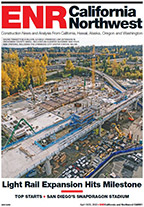According to the Jacobs School of Engineering, the building was equipped with nearly 500 sensors, including 230 accelerometers that measure how fast the building and its nonstructural components move, and 160 sensors and GPS devices that measure relative displacement between two points. There are also 80 cameras inside and out.
Next up will be another shake-table experiment but without the isolators. Hutchinson said the building will be re-anchored to the shake table in a “fixed configuration,” with the motions now transmitted directly into the building. “We expect more severe interstory drifts and defamation demands in the structure,” notes Hutchsinson of the configuration. Simulated temblors may use motions recorded from the 2002 magnitude-7.9 earthquake in Denali, Alaska, and the 2007 magnitude-8.0 temblor in Peru.
Restrepo says the test is scheduled before the end of April, though no exact date has yet been set.
The $5-million program is funded by a coalition of government agencies, foundations and industry partners, including the National Science Foundation, the Network for Earthquake Engineering Simulation (NEES), the California Seismic Safety Commission, the Charles Pankow Foundation and the Society of Fire Protection Engineers.
The last phase, scheduled for mid-May, will feature two days of fire testing on the third floor of the building using, according to NEES, tanks of hepane, a liquid fuel that burns hot enough to simulate full burning within a closed space. Areas of investigation will include how damage from the simulated earthquakes affect the ability of the active and passive fire-protection systems to contain fires and the spread of smoke.
Hutchinson says data analysis will take at least a year. Sensor data also will be sent to the NEES project warehouse, which, according to Joy Pauschke, program director of the National Science Foundation’s NEES program, is a data repository for engineers to develop computational models.


Post a comment to this article
Report Abusive Comment